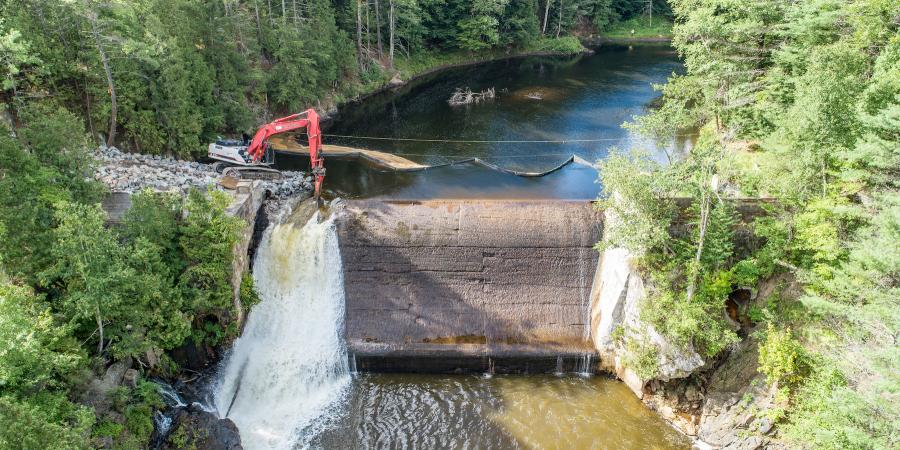 Clean Water
Clean Water
To ensure that our streams, lakes, and wetlands can support a full complement of human and ecosystem needs, AsRA identifies and addresses threats to clean water in the Ausable River watershed.
- Our staff identified the nature and extent of road salt pollution across the watershed and are working to find solutions. Our focus: Mirror Lake, the jewel of Lake Placid and the lake most threatened by road salt in the Adirondack Park.
- AsRA and the Paul Smith's College Adirondack Watershed Institute (AWI) released a report on Mirror Lake documenting that lake turnover is being interrupted as a result of road salt runoff.
- Work by AWI on groundwater contamination, along with AsRA's work on Mirror Lake, was presented to the commissioners of the New York State Departments of Health, Environmental Conservation, and Transportation.
- In response to AsRA's findings, the New York State Department of Transportation launched a pilot salt reduction program along Mirror Lake and the West Branch Ausable River.

Healthy Streams
We’re protecting the shaded, cool waters of the river and its tributaries, restoring their form, function, and resilience for the benefit of wildlife and human communities.
- The 125-year-old Rome Dam on the lower West Branch has been demolished. AsRA advocated for the decaying dam’s removal and was a member of the deconstruction team. Now free, the river tumbles through a steep bedrock gorge, rebuilding habitat, and providing a home and safe passage for native fish.
- Hemmed in by local infrastructure, the West Branch’s Dream Mile has experienced a slow unraveling of capacity, balance, and resilience. AsRA is working with The U.S. Fish and Wildlife Service and Trout Unlimited Adirondack Chapter to restore form and function to this treasured reach, creating stable habitat for trout.
- AsRA and our team of experts have developed a landmark comprehensive plan for restoring the lower half of the East Branch. Extensive surveys and analysis identified 13 projects in the Town of Jay that will increase resilience for communities and ensure the health of the river. Construction on the first two projects will begin in 2020. AsRA is seeking additional funds to expand the comprehensive plan to the Town of Keene and the West Branch.

Biodiverse Habitats
AsRA protects habitats and ecosystems that foster native plant and animal species in and alongside streams, lakes, and wetlands.
- Established in 2018, AsRA's newest program is on the cutting edge of science, using environmental DNA to understand the presence, absence, and abundance of native brook trout. We mapped trout distribution in 35 kilometers of local streams.
- Warmer waters seriously threaten the survival of many native Adirondack species, most notably brook trout. We expanded our year-round temperature monitoring network, doubling its size and our capacity to measure where waters are warming and whether our restoration efforts have a stabilizing effect.
- AsRA is identifying and testing native plant species that provide the greatest success for vegetating streambanks and riparian areas in our watershed. An expert botanist assisted AsRA's staff to survey and assess past planting success and identify key native species for riparian planting projects.

Enjoying the River
We promote responsible, low-impact recreational opportunities that help protect Ausable waterways and adjacent lands.
- AsRA’s river steward maintained eight wader wash stations for West Branch anglers and provided outreach and streamside education for over 500 river users in 2018. Of these, 22 users came directly to the Ausable from a watershed with known aquatic invasive species. Intercepting these anglers allowed us to ensure their gear was properly cleaned. Our riverside surveys show that larger numbers of anglers are choosing non-felt boots and using wader wash stations to prevent invasive species from entering the Ausable.
- The 7th Annual Ride for the River was a great success. Almost 100 riders participated, biking along the river – stopping along the way to learn about how best to protect it – and joining the community party that followed the ride.
- AsRA’s network of Porta-Johns helped ensure a clean and healthy river and provided convenient facilities for travelers and river users.

Engaged Communities
AsRA provides information to inform residents and visitors so they may better care for the health of the watershed where they live, work, and play.
- AsRA’s stewardship brochure, Caring for the Ausable, was mailed to every household in the Ausable watershed. That’s 7,000 opportunities to promote land stewardship and protect our lakes and streams through simple practices in homes, yards, and at work.
- Our public programs provided information and practical tools to hundreds of watershed residents and visitors. Topics included river protection, stream restoration, and science that promotes clean water. And our weeklong intensive teen stewardship program completed its fourth year.
- AsRA’s weekly e-newsletter audience grew to over 600 subscribers in 2018, and our social media following is over 4,000. Added to our growing membership, that’s over 5,000 engaged and informed residents and visitors.
- We planted 300 trees and shrubs on the shoreline of Mirror Lake and at a stream restoration site on the West Branch Ausable River. This project was supported by an Earth Day Initiative Grant from Humanities New York and included volunteers from Mirror Lake Watershed Association and Northwood School.
Download our full 2018 Annual Report.
Sign-up for our e-newsletter to get weekly updates on the latest stories from the Ausable River Association.

